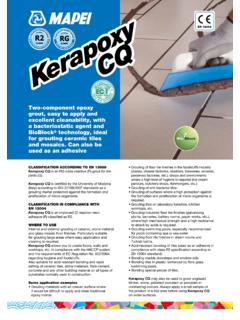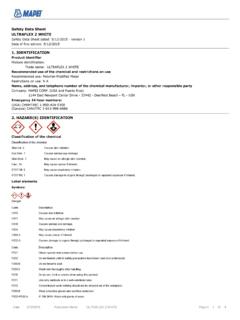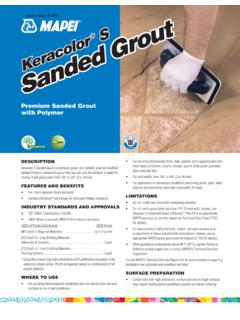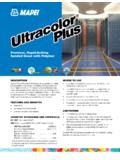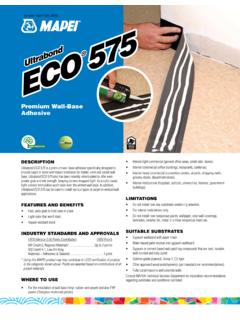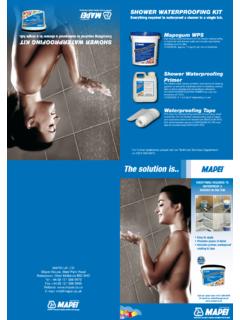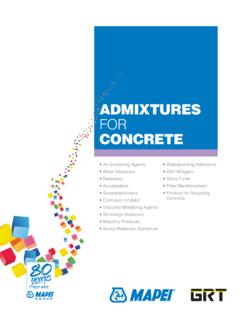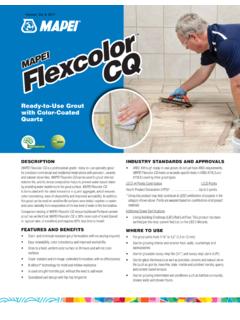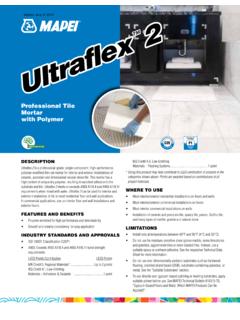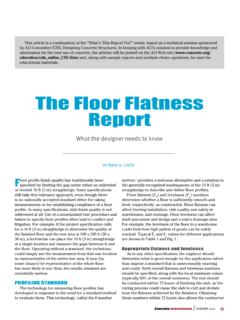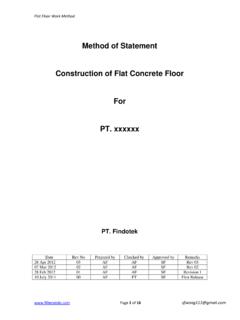Transcription of Technical Notebook LAYING FLOOR SCREEDS - …
1 Technical NotebookLAYING FLOOR SCREEDST echnical NotebookLAYING FLOOR SCREEDS01page 02 1. INTRODUCTION page 03 2. WHAT IS A screed ?page 04 3. Technical AND PERFORMANCE CHARACTERISTICS OF SCREEDS page 07 4. TYPES OF screed page 07 UNBONDED screed page 09 FLOATING screed page 12 BONDED screed page 13 HEATED screed page 17 5. COMPOSITION OF SCREEDS page 17 SPECIAL PRODUCTS FOR NORMAL-SETTING, RAPID-DRYING SCREEDS page 19 SPECIAL PRODUCTS FOR RAPID-SETTING, RAPID-DRYING SCREEDS page 20 ADVANTAGES OF SCREEDS MADE WITH MAPEI SPECIAL BINDERS AND PRE-BLENDED MORTARS COMPARED WITH TRADITIONAL SCREEDS page 22 SUPER-PLASTICISING ADMIXTURES FROM THE MAPEFLUID RANGE FOR MIXING WITH WATER.
2 CEMENT AND SUITABLE AGGREGATES page 22 6. GENERAL GUIDELINES FOR LAYING SCREEDS page 25 7. TYPICAL screed DEFECTS AND REPAIR PROCEDURES1. INTRODUCTIONThe aim of this Technical Notebook is to define the fundamental criteria to be considered when designing and LAYING SCREEDS , and to highlight the products available from MAPEI for LAYING durable service life and functionality of any type of flooring, whether the material used is ceramic, stone, textile, resilient or wood, are highly dependent on the physical and elastic-mechanical characteristics of the substrate on which it is installed.
3 These properties must be defined according to a number of factors, such as the final use of the flooring, which basically means the loads acting on its surface, environmental conditions, the type of flooring to be installed, the compressibility of the underlying layers and any deflections in the concrete FLOOR NotebookLAYING FLOOR SCREEDS02032. WHAT IS A screed ?A screed is a construction element laid in a range of thicknesses, and its purpose is to bring the installation surface for the flooring to the design height and to provide a surface suitable for installing the specified flooring. SCREEDS are usually made from pre-blended mortar mixed with cementitious binders or anhydrite-based binders.
4 Depending on whether it is laid directly on a supporting structure (for example a reinforced concrete FLOOR slab), on an isolating layer (for example a vapour barrier) or on a layer of thermal insulation and/or soundproofing material, it is known as a bonded , unbonded or floating screed . A screed may also have an underfloor heating/cooling system incorporated within its structure and, in such cases, is known as a heated a screed is laid, it must mainly guarantee the following:- that it forms a substrate suitable for installing the specified flooring;- that it is laid on schedule;- that its durability under various service conditions (laid internally or externally, for civil, commercial or industrial flooring, etc.)
5 Is not durability of flooring, therefore, is influenced by the characteristics of its substrate, which means the type of product selected to make the substrate, the quality of preparation work, how it is laid and the compactness and curing of the sum up, when choosing which product to use to make the screed , be it a special binder, a pre-blended mortar or traditional site-prepared mortar, you must take into consideration the final use of the screed , site conditions (internal or external, the thickness to be laid, etc.), the type of flooring to be installed, the time to wait before installing the flooring and the time required before putting the flooring into Technical AND PERFORMANCE CHARACTERISTICS OF SCREEDSTo be suitable for installing flooring, the screed must have the following characteristics:- SUFFICIENT THICKNESS: its thickness depends on the type of screed to be laid (see Section 4 Types of screed ), and must be sufficient for the type of flooring to be installed and the type/intensity of traffic acting on it when in MECHANICALLY RESISTANT.
6 Its mechanical strength, as with thickness, must be sufficient for the final use of the FLOOR and for the type of flooring to be installed. As a general rule, the mechanical strength of a screed suitable for installing any type of flooring for domestic use must be at least 20 MPa, while for industrial use it must be at least 30 COMPACT: the screed must be compact and homogeneous on the surface and through the whole thickness. The presence of layers or areas of crumbly, lower consistency is a sign of poor mechanical characteristics which could cause breakage or detachment of the flooring. These areas must be carefully assessed and, according to the seriousness and extent of the defect, they must be removed and repaired or consolidated with suitable CURED AND DIMENSIONALLY STABLE: before installing any type of flooring, it is absolutely essential that the screed is cured and that most of the shrinkage is completed.
7 In fact, during the curing cycle, SCREEDS are prone to hygrometric shrinkage due to part of the mixing water evaporating or drying off. This may cause curling or cracking (Fig. and Fig. ). If cracks develop after installing the flooring (Fig. ), the FLOOR covering could be damaged and/or become detached. Technical NotebookLAYING FLOOR SCREEDSFig. - Typical sail type deformation of an area of flooring subject to curlingFig. - Schematic diagram of cracks generated by curling in a square area04 Original configurationConfiguration after deformation05 The curing time for a traditional sand-cement screed is around 7-10 days per centimetre of thickness in good weather.
8 Turnaround times for a screed made from traditional cementitious mortar, therefore, can be particularly long (more than 1 month). However, it is possible to reduce curing times considerably by using special admixtures, or by using special binders (such as MAPECEM or TOPCEM) or pre-blended, controlled-shrinkage, rapid-drying and setting mortar (such as MAPECEM PRONTO or TOPCEM PRONTO) in the CRACK-FREE: there are a number of causes of cracks in SCREEDS , such as hygrometric shrinkage, too much water in the mix, the use of aggregates which are too fine or too much cement. Before installing flooring, all cracks must be monolithically sealed by filling them with epoxy resin, such as EPORIP or EPOJET.
9 If there are hairline cracks on the surface of the screed , or if ceramic or stone flooring is to be installed, it is possible to lay an anti-fracture membrane such as MAPETEX on the CLEAN: The surface of the screed must be perfectly clean. Dust, dirt, detached areas, rubble and any other material or substance on the surface of the screed must be removed before installing the flooring to prevent compromising adhesion between the flooring and the screed (Fig. ).- DRY: The level of residual humidity in the screed must be checked. It must conform to the maximum level for that type of FLOOR covering and must be uniform through the whole thickness of the screed , especially when installing flooring sensitive to humidity.
10 For cementitious-based SCREEDS , levels of less than 2% for wooden floors and less than for PVC, rubber and linoleum are considered acceptable. For anhydrite SCREEDS , the level of residual humidity must be less than , whatever type of FLOOR covering is - Serious damage caused by curling at an advanced stateFig. - Ceramic tile detached from a crumbly screedThe level of residual humidity in a screed is measured using an electric or carbide hygrometer (Fig. ).- FLAT: flatness is checked by LAYING a straightedge at least 2 metres long in all directions on the surface of the screed (Fig. ). The maximum acceptable tolerance with this particular straightedge is 2 mm, although the acceptable tolerance varies according to the length of the straightedge used to check for flatness .
